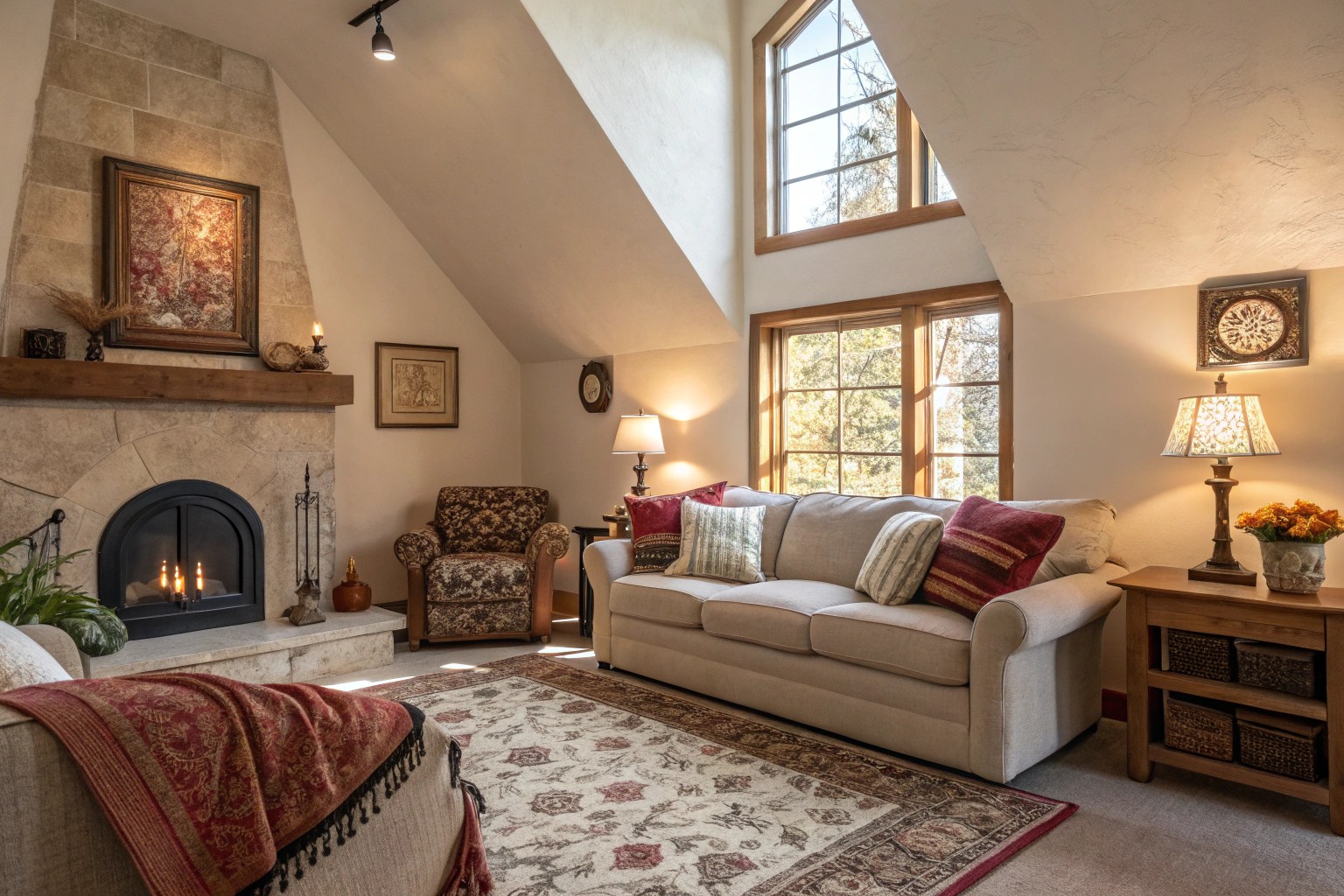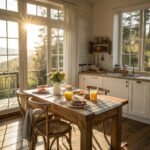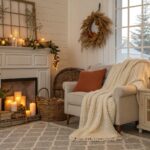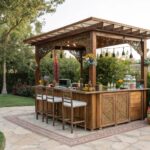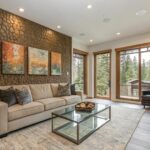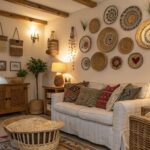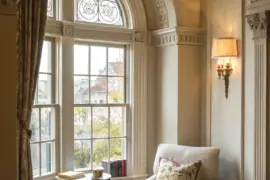Strange wall angles and sloped surfaces present unique design challenges, but they also offer extraordinary opportunities to create distinctive, personalized spaces. Rather than fighting against these architectural quirks, embracing them can transform perceived flaws into captivating features that give character to both interiors and landscapes.
Understanding Different Types of Angles and Slopes
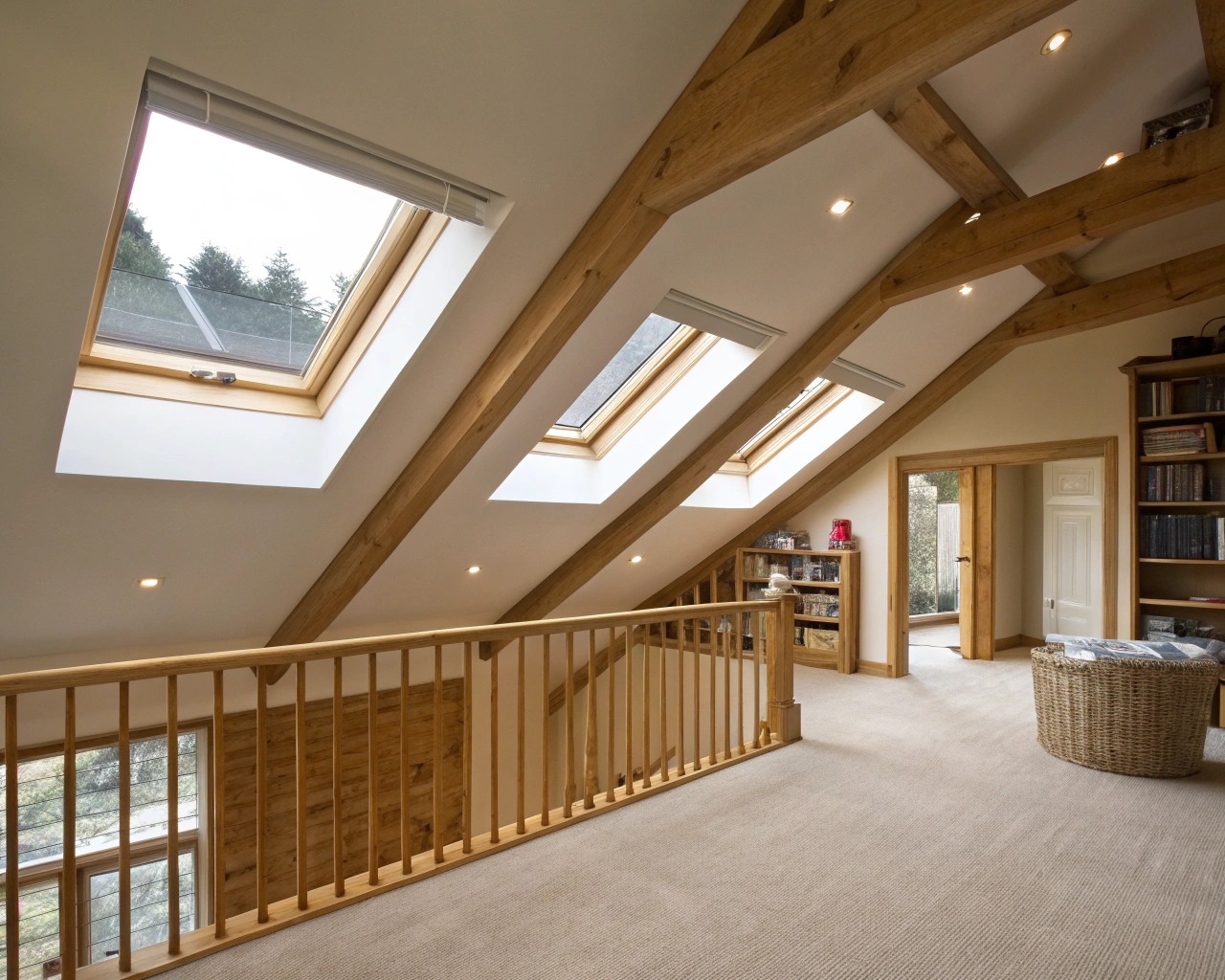
Before developing solutions, it’s essential to identify exactly what type of angular challenge you’re facing. Each requires different approaches:
Interior Challenges
| Type | Description | Common Locations |
|---|---|---|
| Curved Walls | Rounded or semi-circular surfaces | Architectural features, bay windows |
| Diagonal Walls | Walls that veer off at non-90° angles | Modern homes, room transitions |
| Sloped Ceilings | Angled overhead planes | Attics, lofts, under stairs |
| Structural Elements | Protruding columns, beams | Load-bearing requirements |
| Acute Corners | Sharp angles less than 90° | Room junctions, alcoves |
Exterior Challenges
| Type | Description | Management Difficulty |
|---|---|---|
| Gentle Slopes (under 15°) | Slight inclines | Low – Simple planting solutions |
| Moderate Slopes (15-30°) | Noticeable elevation changes | Medium – May require terracing |
| Steep Slopes (over 30°) | Dramatic grade changes | High – Needs retaining walls |
| Irregular Terrain | Multiple elevation changes | Variable – Requires comprehensive plan |
I once consulted on a home with seventeen different wall angles in the main living area. The previous owners had waged war against these angles with heavy drapes and awkwardly positioned furniture. We took the opposite approach—highlighting these unique features while creating a functional space. What was once a “design flaw” became the home’s most distinctive asset.
Interior Solutions for Strange Angles
Making the Most of Curved Walls
Curved walls add distinctive character but require specific approaches:
- Keep furniture centered – When arranging furniture in a room with curves, avoid pushing pieces directly against the curved wall. Instead, maintain some space and centralize the layout to visually separate the furniture from the wall’s curve.
- Consider custom carpentry – For subtle curves, incorporating built-in linear carpentry can introduce a straight edge, effectively counteracting the curve. However, this approach is generally more suitable for minor curves, as extensive custom work can become costly.
- Embrace the curve – Rather than trying to neutralize the curve, lean into it. Adopt a ‘Design by Form’ philosophy where the existing shapes guide the design theme. This might involve incorporating curved shelving, a complementary curved false ceiling, or using soft furnishings that echo the wall’s shape.
- Create a feature wall – Draw positive attention to curved walls by applying textural elements like distinctive wallpaper or decorative tiling, further emphasized with well-placed lighting.
Working with Diagonal and Slanted Walls
Diagonal walls can be transformed from awkward to amazing:
- Arrange furniture strategically – Position furniture pieces perpendicular to angled walls and relatively close to them. This helps integrate the furniture into the non-standard layout. Orienting items inward from different angles can define a unique central space effectively.
- Even out with carpentry – Similar to curved walls, custom carpentry can visually correct a slanted angle. Built-in elements like shelving or a custom table can draw focus, minimizing the impact of the wall’s slant.
- Soften sharp edges – For spaces with acute wall angles (less than 90 degrees), introducing a simple shelf or plank across the corner can soften the sharpness, transforming a challenging spot into a useful nook.
- Use bold colors or patterns – Highlighting a diagonal wall with vibrant paint or eye-catching wallpaper can shift its perception from an architectural oddity to an intentional and striking design element.
Working with a family in Seattle, we encountered a dining room with a dramatic 30-degree wall that made standard furniture placement impossible. Rather than fighting it, we created a custom banquette that followed the wall’s angle, paired with a round table. The unusual angle created a naturally intimate conversation area that became the family’s favorite gathering spot.
Maximizing Sloped Ceiling Spaces
Sloped ceilings create cozy opportunities:
- Tuck beds against slopes – “It’s nice to be able to climb into bed from either side, but it’s not essential. So why not pop a double in against a sloping ceiling? It creates a cosy feel and makes great use of an awkward space.”
- Create specialized zones – A room with a severely sloped ceiling might not be ideal for high-traffic, social activities. However, it could be perfectly suited for a more specific purpose, such as serving as an artist’s studio, a quiet reading nook, or a dedicated meditation space.
- Use wallpaper strategically – Applying wallpaper to the entire sloped ceiling area, including adjacent walls, can unify the space visually and reduce the sense of awkward angles.
- Install recessed lighting – Embedding recessed fixtures along a sloped ceiling effectively highlights the architectural lines while providing even light without encroaching on limited headroom.
- Hang curtains from the highest point – Mounting curtains at the peak of the slope can produce an elegant drape that draws the eye upward, enhancing the room’s perceived height.
Dealing with Structural Elements
Columns, beams, and other structural necessities can become design features:
- Create continuous feature walls – If removing a structural element isn’t feasible, it can be visually integrated. Conceal columns or pillars by incorporating them into a larger, continuous feature wall, perhaps with a curved design to blend them smoothly.
- Add texture and color – Enhance the integrated feature wall with appealing finishes like vibrant paint, mosaic tiles, or wood planks. This helps the original structure disappear into the new design element.
- Transform into functional elements – Convert larger columns into useful surfaces like end tables, or effectively disguise pillars by placing standalone items like tall houseplants or bookcases nearby.
Exterior and Garden Solutions for Slopes
Sloped outdoor spaces present both challenges and extraordinary opportunities. When designed thoughtfully, a sloped garden offers unique vantage points and natural transitions impossible on flat terrain.
Evaluating Your Slope
Before beginning any landscape project on a slope, thorough assessment is critical:
- Determine the gradient – Calculate your slope’s grade by dividing the vertical rise by the horizontal run. This will help determine appropriate interventions.
- Analyze soil type – Understanding the soil composition is crucial as it affects drainage and erosion potential. Sandy and silty soils drain faster and erode more easily compared to clay soils.
- Assess drainage patterns – Observe how water flows across your property during rainfall to identify potential problem areas.
- Consider access requirements – Evaluate the ease of navigating the slope, considering needs for both the construction phase and future maintenance activities.
When visiting a steeply sloped property in the Pacific Northwest, the owners were frustrated by constant erosion and unusable outdoor space. What struck me wasn’t the challenges—though there were many—but the potential for creating distinct outdoor rooms with spectacular views. By working with the slope rather than against it, we created three distinct terraces, each with its own character and purpose.
Retaining Wall Solutions

Retaining walls are fundamental elements for managing slopes:
Material options include:
- Treated pine sleepers – clean and durable
- Concrete sleepers – allows higher walls with no rot
- Stone walls – natural and sturdy
- Besser blocks – attractive and easy to install
- Railway sleepers – economical and rustic
- Gabion baskets – modern and excellent for drainage
- Terracing approach – Implementing terracing levels sloped areas into functional spaces, resulting in a garden rich with interest and distinct zones designated for specific uses.
Benefits of terracing include:
- Creation of functional zones for patios, firepits, outdoor living areas, children’s play spaces, and garden beds
- Prevention of soil erosion and runoff washing away nutrients and seedlings
- Improved ease of navigation and maintenance within the garden
- Enhanced overall visual appeal of the outdoor space
Slope Angles for Construction
When building retaining walls, understanding slope angles is crucial:
| Soil Type | Maximum Slope Angle |
|---|---|
| Rock | 90° (vertical) |
| Clay and loam | approx. 45° |
| Gravel and sand | approx. 60° |
| Non-cohesive soils | approx. 45° to 60° |
These guidelines from DIN 4124 serve as a basis for planning, but should be adapted depending on your specific project conditions.
Planting Strategies for Slopes
Strategic planting is essential for slope stabilization and aesthetic appeal:
- Ground cover plants – Utilizing ground cover plants is key to stabilizing soil and preventing erosion, a frequent issue on slopes. Opt for fast-establishing varieties such as creeping thyme, periwinkle, or juniper to quickly cover and secure the soil.
- Drought-resistant options – Selecting native ground covers adapted to your local climate and soil conditions offers a low-maintenance and environmentally friendly solution for slope planting.
- Rock garden approach – Rock gardens are well-suited for sloped areas because they need minimal soil and effectively aid in erosion control. The technique involves strategic placement of large rocks, filled in with soil and planted with succulents or other drought-tolerant species suited to rocky environments.
- Edible slope gardens – Sloped gardens can be transformed into productive edible landscapes, taking advantage of the vertical space to cultivate various fruits, vegetables, and herbs. Consider planting perennial options like berries and asparagus on steeper sections to minimize soil disturbance.
- Strategic tree placement – Incorporating vertical elements like a tree, pergola, or archway draws the eye upward, helping to divert attention from potentially awkward angles elsewhere in the landscape.
Managing Oddly-Shaped Outdoor Spaces
For backyards with unusual boundaries or shapes:
- Use curves to distract from angles – Introducing curves and circles into the landscape design is effective because the eye naturally follows these shapes, softening the impact of sharp angles.
- Follow the house, not the fence – A key principle is to align primary landscape lines, like paths or patio edges, perpendicular to the house, rather than mirroring angled fence lines. Following the fence can unintentionally emphasize the irregular shape.
- Embrace unique shapes – “While odd-shaped backyards do present design challenges, their imperfections make them so much more interesting than cookie-cutter square or rectangular gardens.”
- Create false boundaries – For awkwardly shaped corners or edges along the garden perimeter, strategic planting of trees, flowers, and shrubs can fill these spaces, effectively creating the visual impression of a more regular square or rectangular central yard area.
Design Principles for Any Angle or Slope
Certain fundamental principles apply whether you’re working with interior angles or exterior slopes:
The Embrace or Disguise Decision
One of inescapablen decisions you’ll face is whether to highlight or minimize unusual angles:
When to embrace:
- When the angle creates a distinctive architectural statement
- If disguising would require extensive, expensive modifications
- When the angle offers functional opportunities
- If the angle contributes to the home’s character
When to disguise:
- If the angle severely compromises functionality
- When multiple competing angles create visual chaos
- If the angle creates safety hazards or accessibility issues
In my practice, the most successful designs typically incorporate elements of both approaches—acknowledging unusual architecture while ensuring spaces remain functional and harmonious.
Creating Strategic Focal Points
Focal points draw attention where you want it:
- Strategic art placement – Large-scale artwork or a gallery wall can add a unique touch to angled walls while directing visual focus.
- Architectural features – Consider adding details like molding or trim along a sloped wall. This technique can make the slope appear more polished and intentional.
- Dramatic lighting – Highlight architectural elements with spotlights, wall sconces, or pendant lights to transform quirks into features.
- Statement furniture – A distinctive piece positioned carefully can become the room’s centerpiece, minimizing perception of unusual angles.
Using Height Effectively
Vertical elements create balance and draw the eye upward:
- Tall plants – Strategic placement of trees or tall indoor plants can create vertical interest, effectively drawing the eye upward and away from awkward horizontal angles.
- Vertical design elements – Pergolas, archways, or tall shelving units create vertical interest that balances unusual horizontal angles.
- Graduated plant heights – In sloped gardens, using plants of varying heights creates natural transitions between different levels.
Case Studies: Transformations
The 45-Degree Living Room Challenge
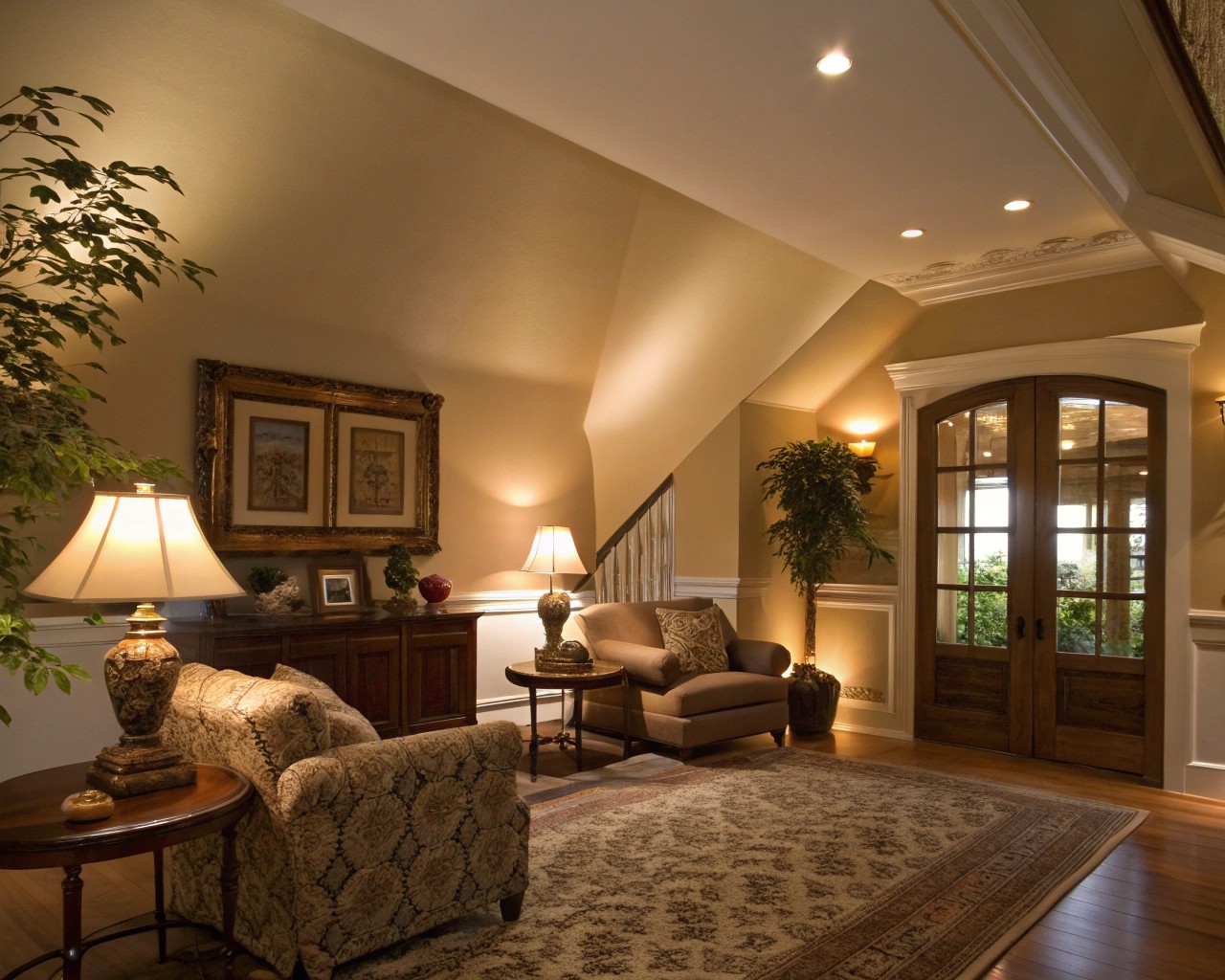
A client purchased a 1980s suburban home with a living room featuring a pronounced 45-degree angled wall—the type that, as many designers note, often “SCREAMS cheap.” The previous owners had pushed a sofa against this wall, creating awkward dead space behind it.
Our approach:
1. Pulled furniture away from walls, creating a floating arrangement oriented toward a new fireplace
2. Added a custom bookcase that fit perfectly into the angled corner, turning dead space into functional storage
3. Installed diffused lighting that softened harsh angles
4. Used a circular rug to anchor the seating area and counter the angular architecture
The result transformed what was once considered the home’s biggest flaw into its most distinctive feature—a conversation starter rather than an eyesore.
The Terraced Hillside Garden
A steeply sloped backyard (approximately 30-degree grade) was essentially unusable before intervention:
Our solution:
1. Created three distinct terraces using natural stone retaining walls
2. Installed a cascading water feature that followed the natural grade
3. Designed switchback pathways with gentle stairs connecting levels
4. Planted drought-resistant ground covers between terraces to prevent erosion
5. Positioned seating areas on each level to take advantage of different views
The multi-level garden now offers distinct spaces for dining, relaxation, and gardening—maximizing what was once considered unusable space.
The Attic Master Suite
An attic conversion with severely sloped ceilings and unusual angles seemed impossible to furnish effectively:
Our approach:
1. Positioned the bed where ceiling height was greatest
2. Created custom built-in storage that followed roof angles precisely
3. Installed skylights to brighten darker corners
4. Used the lowest ceiling areas for seating nooks and less-frequented functions
5. Employed consistent materials throughout to unify the space
The result was a cozy, functional retreat that embraced rather than fought against the architectural constraints.
https://epg.modot.org/index.php/321.1_Design_of_Earth_Slopes
https://www.bhg.com/gardening/landscaping-projects/landscape-basics/slope-solutions/
https://www.gardendesign.com/landscape-design/hillside.html

